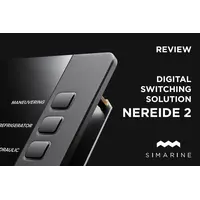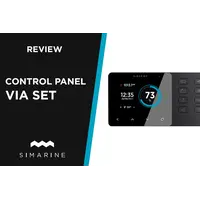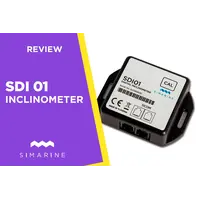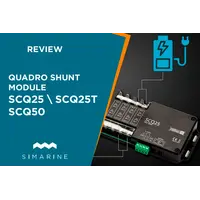topRik team continues to introduce you to the capabilities of Simarine PICO system monitor. Introducing the next module of the system – Simarine SN 01 NMEA 2000 gateway. This gateway allows you to transfer data from any device connected to the PICO battery monitoring system: the state of the batteries themselves, tanks, temperature readings, etc. The variety of possibilities depends on the connected modules, shunts, shunt modules, including inclinometer, fuel tank level sensors, water, wastewater, some weather readings, etc.
If your yacht already has Simarine PICO system monitor installed, it might be a good idea to get a SN 01 NMEA 2000 gateway in our marketplace to be able to control the operation of the yacht's most important electrical equipment. Not just the comfort of the crew, but also its safety in conditions of both coastal and long-distance navigation largely depends on this.
And if you don’t yet know about the features of Simarine PICO system monitor, you can find an overview of all its versions here. Or contact our experts for free consultations. These are experienced sailors and will give professional advice on what modules are needed for a particular boat's monitoring system.

Key Features and Specifications
When another navigational electronic marine novelty appears on the market, in particular – modules of Simarine PICO system monitor, which constantly expand the capabilities of the system, it is almost impossible to do without NMEA 2000.
The first part of this designation (NMEA) indicates that in this case we are talking about an interface device for exchanging data between devices. But few people even among true electronics fans know what is hidden behind the number 2000.
NMEA is an abbreviation for National Marine Electronics Association – created by American marine electronics manufacturers and distributors association. The association has developed numerous standards that have become known throughout the world. Among them there are various descriptions of the procedure for exchanging data between devices on yachts and ships.
The most well-known standard is NMEA 0183, which describes the most common interfaces today. This standard dates back to 1983 and has since been regularly modified and improved to meet growing user requirements. However, it has certain technical limits.
Over time, the need arose to develop a new standard, primarily associated with the increasing volume of data, as well as the constant complication of organizing a data exchange network not only on yachts, but also in industrial and military shipping.
The new standard was called NMEA 2000 (also abbreviated 2k in the designation) and began to cover the entire on-board network. It has practically nothing in common with its predecessor, the classic NMEA 0183 interface. Therefore, it is not so easy to combine 0183 and 2k interface devices. This fact is especially important when the number of on-board electronic devices increases, since devices have already appeared that work only using the NMEA 2000 protocol. These are the modules that are included in Simarine PICO system monitor.

Let's take a short excursion into the world of NMEA 0183 to better understand the essence and advantages of the new system.
NMEA 0183
The classic specification is based on the traditional serial interface of computer technology and still has a wide range of applications. If you have only one data source and few sinks, a simple design can save a lot of money from a technical and logical point of view. For example, in cases where only one GPS plotter transmits data to the autopilot and DSC transmitter.
A big plus is the recognizable data format - the data is transmitted as unencrypted text. In the case of GPS mice for computers, a similar format gradually became a de facto standard, since every navigation program understands such information records.
The standard speed is only 4800 bits per second, but this is sufficient for receiving location information from the GPS system and transmitting data. However, with the advent of the Automatic Identification System (AIS), certain limits appeared, and the speed had to be increased to 38,400 bits per second.
By now, such a simple design has already reached its limits. After all, only one device can transmit data to each NMEA 0183 communication channel. In addition, there is no way to create a single access control that could work with multiple sources over the same cable. For example, an anemometer requires a speed measured by a log to calculate the true wind; then this data must be transferred to the plotter, which requires two independent electrical connections; another cable is required for the compass so that the radar overlay can be adjusted on the navigation screen; let's add here an echo sounder, AIS, autopilot... The system becomes more and more complex, and finally it becomes problematic to develop a system that, on the one hand, transmits the necessary data to all devices, and on the other, does not form closed loops through which they could repeatedly circulate old data.
Connections Without Closed Loops
The most important innovation of the NMEA 2000 protocol is that all devices can exchange data with each other over one bus, that is, all devices transmit their information over one communication channel, of course, time-separated. All devices connected to the bus have automatic access to all data, so there is no more guesswork when laying out electrical connections, as there is only one data backbone.
The basis for building a network is the industrial standard CAN (Controller Area Network), due to which the cost of hardware remains low, because the necessary elements are available from most manufacturers in sufficient quantities. In addition, similar technology has already been tested on other vehicles. Network configuration is performed automatically, but it is possible to assign individual numbers to most devices. If there are multiple sources online for a single metric, you can usually select one as your preferred one.
The NMEA-2000 protocol consists primarily of one end-to-end network bus (backbone), from which tributary lines extend to individual devices. The maximum cable length can be 200 m, which is more than enough to cover all points on board the yacht.
The NMEA bus also “took care” of the plug connectors: those that connect to the network backbone are unified, protected from water and hermetically connected using clamping couplings. Externally, they are T-shaped connectors for connecting tributary lines. Manufacturers have some freedom of action when it comes to connecting them to devices: connections with threaded terminals can only be made in protected areas. It is recommended that you plan ahead for any possible expansions as they will require additional cables and T-connectors.

As you can see from the photo above, the local Simarine gateway SN 01 NMEA 2000 can be connected to the general ship NMEA 2000 if a large yacht is equipped with a large number of electrical equipment that requires monitoring separation. Using the gateway, PICO can also display a range of engine and transmission parameters if they are connected to the NMEA network. This is in addition to the functions of the connected PICO modules, which allow control of switch banks, communication of battery status, tank level and some environmental information.
The NMEA 2000 data transfer rate is 250,000 bits per second. Any uncapped end of the cable will cause the signal to be reflected, as is the case with waves hitting a pier. However, at such a high speed, this will cause all the data to be mixed up; therefore, a matched load should be placed at both ends of the network backbone, which acts as a “coastal reed bed” that absorbs waves and does not create echoes. In practice, the entire design looks like a sealed plug without cable, and the matched load is located inside.
The tributary lines leading to the instruments are not provided with a matched load and for this reason their length is limited to 6 m. This only leads to a slight problem with the transmitter of the wind measurement device, since, as a rule, the height of the masts is higher. Running a network backbone first up and then down is impractical due to the double cable consumption, so manufacturers have two options.
- The transmitter, as before, is connected to the display with wind information, and only then the structure is connected to the NMEA-2000 system. Such a connection does not correspond to the principle of creating a single system and requires serious effort, however, practical use is extremely simple, as we see in the example of Simarine PICO System Monitor.
- The essence of the second option is to hang the air transmitter at the end of the network highway with a built-in matched load, thereby creating a single system. However, in this case, there is no short circuit when the mast is folded, and the system may fail from time to time. In this case, it is useful to have a matched plug on hand.
Installation and Configuration
Because Simarine SN 01 is a module that is installed in the yacht's electrical system; its installation must be carried out by a specialist with the appropriate approvals, equipped with professional tools and protective equipment.
When installing, you should follow the diagram and description of the step-by-step process contained in the manufacturer's instructions.
Functionality and Integration
Simarine module The SN 01 NMEA 2000 Gateway can be used to convert measurement data from Simarine products to NMEA 2000 format. It easily connects to a NMEA 2000 network via a standardized Micro-C plug connection, allowing you to:
- monitoring and data management, depending on the connected sensors and modules of Simarine PICO System Monitor ;
- integration with other ship systems - autopilot, echo sounder, engine control system, etc.;
- software updates;
- display the output on any suitable display or multifunction device on a NMEA 2000 network;
- plug-and-play communication standards .
The table below shows the possibilities of Simarine SN 01 NMEA 2000 Gateway for data reception and transmission.

Advantages and Disadvantages
Sometimes it can be difficult to separate certain product features into pros and cons, as is the case with instruments that have the NMEA 2000 logo but come from different brands.
For example, although the NMEA 2000 protocol is relatively fast, it is not designed for transmitting video signals, radar images, or maps. To solve such problems, an alternative network can be created on board using the Ethernet protocol, capable of exchanging data with a network operating under the NMEA 2000 protocol.
Therefore, manufacturers whose devices bear the NMEA 2000 logo have carried out certain tests and provided evidence that all requirements in accordance with the NMEA 2000 specification have been met. On the one hand, this, of course, is associated with significant costs, on the other hand, with certain restrictions.
Therefore, equipment from some manufacturers (for example, Seatalk NG from Raymarine, Simnet from Simrad, and also SN 01 from Simarine) although compatible with the NMEA-2000 protocol, is produced under its own brand. In a similar way, Simarine can, for example, use much thinner plug connections. Here you have the pros and cons in one bottle.
Advantages
But there are also undeniable, 100% advantages that the Simarine SN 01 module has:
- reliability and stability of operation;
- wide compatibility with various devices, and of course - with all modules of Simarine PICO system monitor;
- ease of installation and configuration;
- manufacturer's warranty for 3 years.

Technical Support and Service
As with most products included in Simarine PICO system monitor, the SN 01 NMEA 2000 Gateway has a three-year warranty period. During this period, if the module malfunctions, it will be repaired for free or simply replaced with a working one. Restrictions are usual: unauthorized hacking of the device or other violations during operation.








